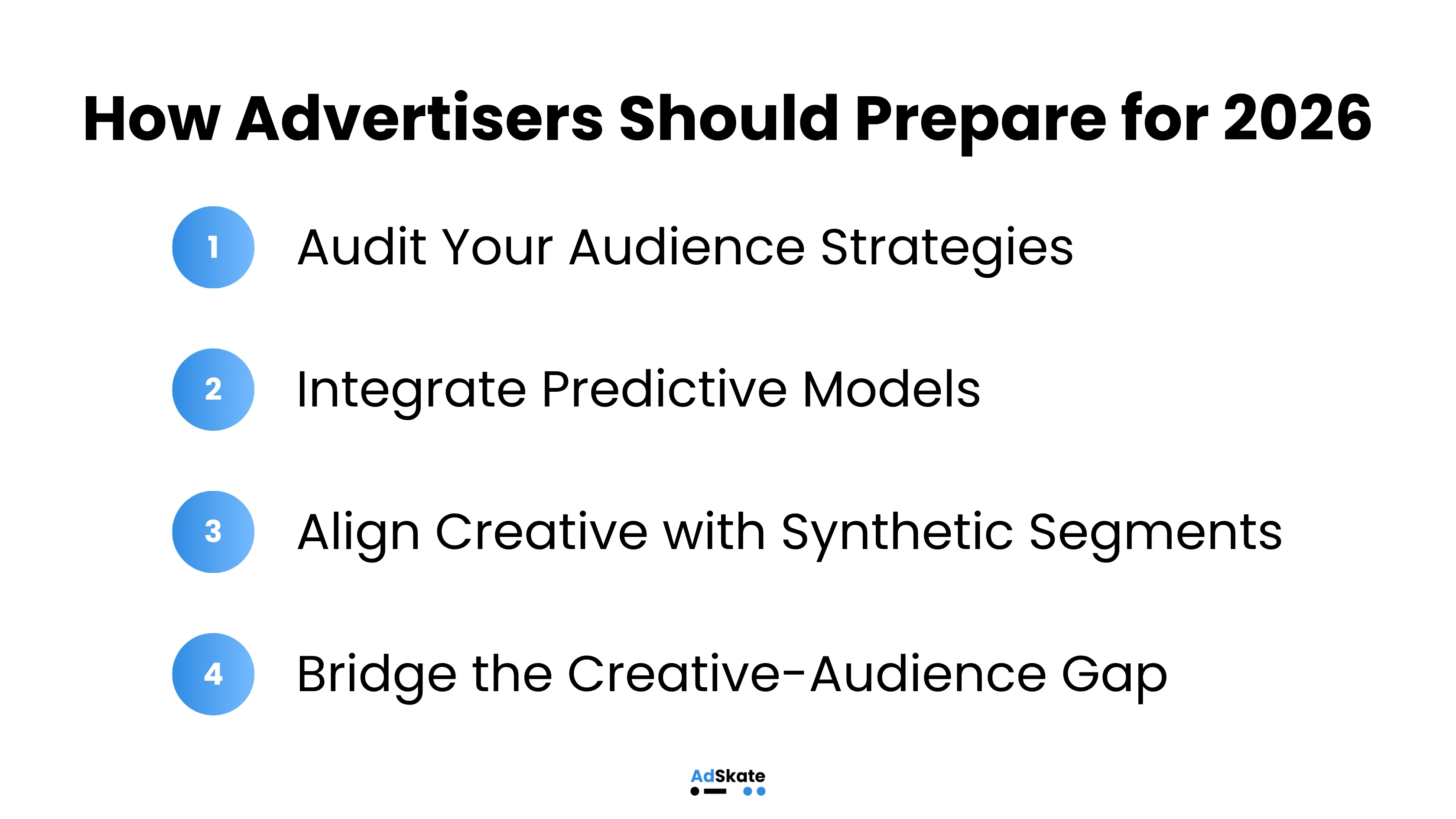Why Synthetic Audience Analysis Will Be Mission-Critical for Advertisers by 2026
.webp)
The Audience Reckoning Has Arrived
The landscape of advertising is undergoing a seismic shift. Third-party cookies are vanishing, privacy regulations are tightening, and platforms are restricting access to granular data. For marketers and advertisers, this means the playbook for reaching the right audience, at the right time, with the right message, is being rewritten.
This upheaval is forcing a fundamental rethink of how audience targeting is done. Enter synthetic audiences: a fast-emerging tool that is poised to define marketing effectiveness in 2026. These strategies are enabling advertisers to predict behavior, refine messaging, and optimize campaigns with unprecedented precision.
Read about how US Bank is using synthetic audiences here.
.webp)
II. What Are Synthetic Audiences?
Synthetic audiences are AI-generated, predictive audience segments built by analyzing patterns across contextual, behavioral, demographic, and creative data. Unlike traditional segments, often static and broad, synthetic audiences are dynamic, scalable, and tailored to specific campaign objectives.
At their core, synthetic audiences use:
- Behavioral data
- Contextual signals
- Research data
- Predictive models trained on outcomes
They don’t rely on direct identifiers or third-party cookies. Instead, they simulate real user groups by recognizing the traits and actions that correlate with campaign success.
III. Why Traditional Audience Strategies Are Failing
Legacy approaches to audience segmentation, relying on demographics, geography, or purchase history, are collapsing under modern constraints:
- Data Loss: Cookie deprecation, Apple’s App Tracking Transparency (ATT), and GDPR have dramatically reduced the granularity of user-level tracking.
- Creative Blind Spots: Creative and audience often exist in silos, resulting in mismatches between messaging and actual audience intent.
- Signal Scarcity: Platforms like Meta and Google now offer less transparent audience reporting, making targeting feel like a black box.
Want to go learn more? Check out our podcast episode with Myles Younger of U of Digital, where we discuss why the old model of data is broken, and how synthetic audiences can capture more emotional nuance and predictive power in creative strategy.
🎧 Listen to the full episode here
IV. The Rise of Synthetic Audiences: A Strategic Advantage
Brands adopting synthetic audiences are gaining a distinct edge, both in speed and performance.
Key advantages include:
- Hyper-Precision: Create nuanced personas that map closely to real intent signals.
- Creative Alignment: Match creatives to audience emotional states, cultural preferences, or behavioral profiles.
- Speed to Insight: Run pre-campaign simulations to test messaging resonance before launch.
Example Use Case:
A CPG brand aiming to launch a new beverage line used synthetic audiences to test creative across Gen Z emotional drivers (nostalgia, rebellion, sustainability). The pre-campaign test revealed a 38% lift in engagement when creative leaned into eco-consciousness themes, a result that informed national campaign rollout and packaging.
V. The Role of Deep Audience Analysis
Audience analysis is the foundation that powers effective synthetic audience generation. It involves using AI tools and natural language processing to uncover how people respond to creative stimuli, colors, tone, visuals, language, before a campaign ever goes live.
This process enables:
- Understanding emotional drivers and cultural resonance
- Identifying gaps between audience expectation and creative delivery
- Forecasting campaign performance based on past behavioral patterns
Audience analysis doesn’t replace creativity, it sharpens it. It ensures that insights inform not just what you say, but how you say it and who you say it to.
VI. How Advertisers Should Prepare for 2026
To stay competitive, advertisers and marketers need to evolve now. Here’s how:
1. Audit Your Audience Strategies
- Are you relying on third-party data?
- Is your segmentation broad or behaviorally intelligent?
2. Integrate Predictive Models
- Use tools that can simulate outcomes before launch (learn about how AdSkate can help here).
- Prioritize platforms that blend creative analytics with audience insights.
3. Align Creative with Synthetic Segments
- Don’t just test creative in isolation. Test it against specific audience traits.
- Look for patterns in what messaging resonates with what synthetic profiles.
4. Bridge the Creative-Audience Gap
- Ensure that creative teams have access to audience insights early in the process.
- Build feedback loops that allow insights to refine both targeting and execution.

VII. Looking Ahead: The Future of Campaign Targeting
As 2026 approaches, the marketing world will become increasingly reliant on data-smart creativity. Campaigns will succeed or fail based on how well brands can simulate their audiences, understanding not just demographics, but motivations, preferences, and emotional states.
Synthetic audiences, powered by real-time insights and creative analytics, will lead this charge. They represent the marketer’s best path to relevance in a privacy-first world.
VIII. Ready to See Synthetic Audiences in Action?
AdSkate’s audience analysis platform allows advertisers and marketers to pre-test creative against AI-modeled synthetic audiences, before launching a campaign.
This means you can:
- Simulate how different audience groups will react to your creative
- Identify the highest-performing combinations of message, tone, and visual style
- Reduce media waste by aligning creative with the right audience from the start
Whether you’re launching a new product, rebranding, or optimizing your next campaign, AdSkate gives you the insights you need, faster, and with more precision.
Try AdSkate’s audience analysis today and put synthetic audiences to work for your brand.
.webp)
.webp)
.webp)
.webp)
.webp)
.webp)